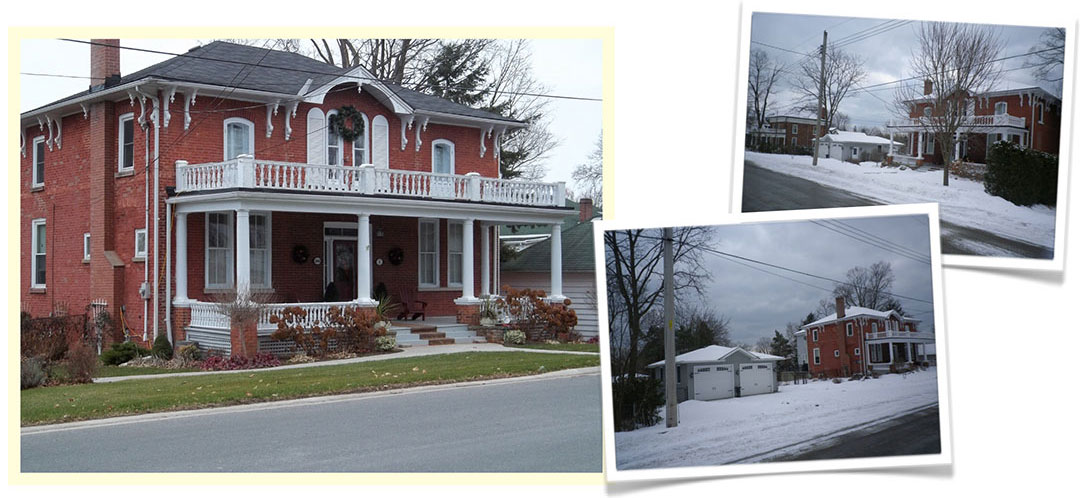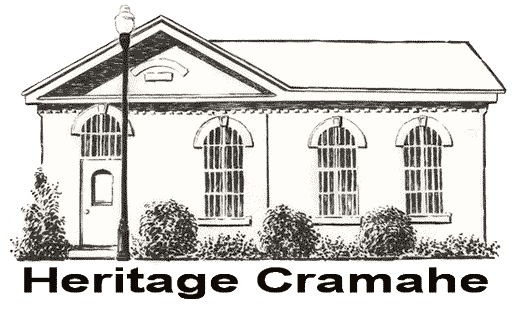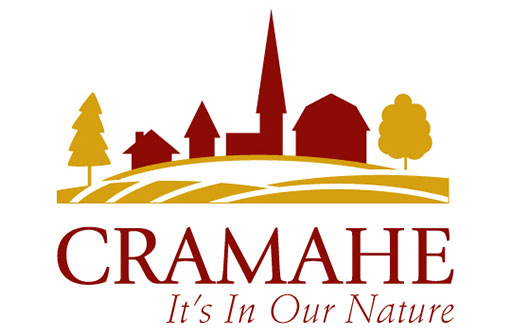4 North Street, Colborne
(c.1860s)
Roll No.1411-012-020-23200 – Cramahe Township Ontario

Georgian Vernacular
At first glance, No. 4 is classic Georgian architecture which is defined by a square two story centre hall plan with two principal rooms, two deep on the main floor. The most prominent Georgian feature is the symmetrically spaced windows, referred to as “5 Bay”, The front door too sets the Georgian apart with its glass transom and sidelights together with the entablature and pilasters of Greek architecture that create the most impressive feature of a plain Georgian facade. A Palladian window above the front door is another common feature, In this case it is a double.
No. 4 differs from this strict design aesthetic in several ways. The tall, slim, rounded window sashes are a nod to the Italianate as are the decorative brackets and verge board in the front gable. The windows are paired rather than evenly spaced and there is a single opening on each side of the upper floor and two each side on the main floor. The front door is a more restrained design.
The two story front porch was probably present in the 1860s because the upper East and West openings are actually doors. The spindles and doric columns add grace, functionality and elegance to the facade.
No. 4 has beautiful plaster friezes both upstairs and down, original to the house and a sign of the affluence of the owner/ builder. Some were hidden for decades before being revealed during renovations.
The full height concrete basement covering the entire footprint of the house where “below stairs” staff lived and worked is unique. A large two story addition built after 1900 moved the kitchen upstairs for the first time.
This house is one of the most attractive, best preserved and maintained in the county.
History or Associative Value
4 North Street is next door to the William Coxall house, built in 1888 and there is some speculation that William Coxall lived in No.4 while he built No.8 for his daughter, having bought the relevant lots from Nelson Dailey in 1881. His daughter, Elizabeth Philp sold No.8 in 1902 to George Sanderson who was retiring from the farm known today as the “Fannin” House. In 1904, William Coxall’s widow sold No.4 to Henry Mayhew, a Colborne jeweller, and his family lived there for 42 years.
Additional Historical and Genealogical Information
Although the Clergy reserve system wasn’t to end until 1854, the northern half of Lot 31, including all of the land in the reserve that is now part of Colborne, was granted by the Crown to Joseph Abbott Keeler (1788-1855) (LINK) on 12 April 1842.
On 23 September 1854 Joseph A. Keeler transferred his 135 acres in Lot 31 to his son Joseph Keeler III (1824-1881) (LINK). This Joseph Keeler and his wife Octavia (née Phillips, 1827-1899) mortgaged the property with the Commercial Bank of Canada on 29 March 1855.
The Commercial Bank sold Reid Lot 257 to George Knight (ca. 1822-?) on 8 May 1863. Knight is listed in the 1861 Cramahe census with his wife Eliza (ca. 1822-?) and two sons George (ca. 1850-?) and Arthur (ca. 1857-?). No occupation is noted, but Land Office records refer to him as a painter. By 1865 he and his family were living in Rochester, New York, and he was a resident there when he sold Reid Lot 257 to Joseph Nelson Dailey (1840-1928), Napoleon Bonaparte Dailey (1845-1877), and George Nelson Gordon (1819-1880) on 21 April 1874. Gordon and the Nelsons already owned several adjacent properties at the time.
The Daileys were sons of Colborne grocer Daniel Dailey (1803-1889), and were themselves farmers. In 1871, Nelson farmed land in Concession 1, Lot 34, and Napoleon in Concession 1, Lot 33. Both of these lots are just a little to the west of Colborne, which extends west to include Lot 32. Gordon was a tinsmith who moved to Colborne from Cobourg in around 1860. There are a couple of intriguing circumstantial hints about the connection between Gordon and the Daileys. There is a photograph on page 80 of “How Firm a Foundation” (Argyris 2000) showing a group of militiamen lined up in Victoria Square sometime “prior to 1870”. In the background is a storefront labelled “G. N. Gordon” and immediately next door is one labelled “Cheap Groceries”. Was this Daniel Dailey’s grocery store? Also, marriage records for Nelson Dailey and for George Gordon’s son James Wilmot Gordon (1852-1941) are immediately adjacent to each other in Colborne records. So they were married on the same day in the same place. Finally, the Gordons and the Daileys appear sequentially in the 1872 census.
On 5 June 1875 the Daileys and Gordon sold the property to Thomas Brown (1846-1911), a commercial traveller, who immediately (7 June 1875) sold it to Richard Gibson (ca. 1837-?), a Colborne tanner and currier. A year later (29 July 1876) Gibson sold it to Henry Smedley (1843-1907), a Colborne bricklayer, and then Smedley sold it back to Joseph Nelson Dailey on 13 November 1877.
Dailey sold Lots 257 and 258 to Colborne storekeeper William Coxall (1842-1902) on 5 January 1881. Coxall married three times. When he purchased the property in 1881 he was married to Elizabeth Gillespie (1846-1887, married 1865). They had four children: Amelia E. (1867-?), Elizabeth Adeline (“Lina”, 1869-?), Robert Lawrence (1877-1916), and William Gillespie (1883-1883). Elizabeth Gillespie Coxall died in 1887 and William married Emily Bennett (1865-1893) in 1888. Two further children resulted from this marriage: Mary Gladys (1889-?) and John Grover (1893-1893). Emily Coxall died in 1893 and William married his third wife Martha Jane Strong (1846-?) in 1898.
On 15 June 1904, the property passed to Colborne jeweller Henry Joseph Mayhew (1873-?), who acquired it from the Estate of William Coxall. He owned it until after 1821. Mayhew married Janet Harriet Rutherford (1874-?) in 1897 and had four children: Isabella Janet (1899-?), John Douglas (1903-?), Hubert A. (1905-?), and Annie Ruth (1909-?).
Knight purchased Lot 257 from the Commercial Bank for $100 in 1863 and sold it for the same amount to the Daileys and Gordon in 1874. Lots 252, 257 and 258 went to Thomas Brown in 1875 for $500, and two days later Brown sold Lots 257 and 258 to Richard Gibson for $300. Gibson got 280% of his purchase price when he sold the same lots to Henry Smedley for $840 in 1876. Smedley got less than he had paid for them ($600) when he sold them back to the Daileys in 1877. The properties remained in the hands of the Daileys until 1881 when they went to William Coxall for $1600 (267% of their purchase price). Coxall sold them to Mayhew for $1450. Large increases in land value often reflect improvement to a property. This might suggest that the house was added to Lot 258 either by Richard Gibson or by the Joseph Nelson Dailey.
The Mayhew family was resident on the property in the 1911 and 1921 censuses. The Coxalls probably lived there as well, because they owned no other residential property in Colborne after 1885 and because William Coxall’s daughter Lina owned the house next door on Reid Lot 259 (now 8 North Street) after 1889. It is unclear who else may have lived there.




